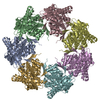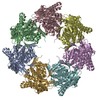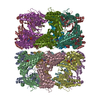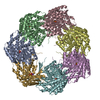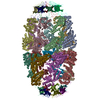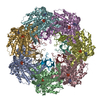+Search query
-Structure paper
| Title | Asymmetric apical domain states of mitochondrial Hsp60 coordinate substrate engagement and chaperonin assembly. |
|---|---|
| Journal, issue, pages | bioRxiv, Year 2023 |
| Publish date | May 15, 2023 |
 Authors Authors | Julian R Braxton / Hao Shao / Eric Tse / Jason E Gestwicki / Daniel R Southworth /  |
| PubMed Abstract | The mitochondrial chaperonin, mtHsp60, promotes the folding of newly imported and transiently misfolded proteins in the mitochondrial matrix, assisted by its co-chaperone mtHsp10. Despite its ...The mitochondrial chaperonin, mtHsp60, promotes the folding of newly imported and transiently misfolded proteins in the mitochondrial matrix, assisted by its co-chaperone mtHsp10. Despite its essential role in mitochondrial proteostasis, structural insights into how this chaperonin binds to clients and progresses through its ATP-dependent reaction cycle are not clear. Here, we determined cryo-electron microscopy (cryo-EM) structures of a hyperstable disease-associated mtHsp60 mutant, V72I, at three stages in this cycle. Unexpectedly, client density is identified in all states, revealing interactions with mtHsp60's apical domains and C-termini that coordinate client positioning in the folding chamber. We further identify a striking asymmetric arrangement of the apical domains in the ATP state, in which an alternating up/down configuration positions interaction surfaces for simultaneous recruitment of mtHsp10 and client retention. Client is then fully encapsulated in mtHsp60/mtHsp10, revealing prominent contacts at two discrete sites that potentially support maturation. These results identify a new role for the apical domains in coordinating client capture and progression through the cycle, and suggest a conserved mechanism of group I chaperonin function. |
 External links External links |  bioRxiv / bioRxiv /  PubMed:37293102 / PubMed:37293102 /  PubMed Central PubMed Central |
| Methods | EM (single particle) |
| Resolution | 2.5 - 3.8 Å |
| Structure data | EMDB-29813, PDB-8g7j: EMDB-29814, PDB-8g7k: EMDB-29815, PDB-8g7l: EMDB-29816, PDB-8g7m: EMDB-29817, PDB-8g7n: EMDB-29818, PDB-8g7o: |
| Chemicals |  ChemComp-ATP:  ChemComp-MG:  ChemComp-K: |
| Source |
|
 Keywords Keywords |  CHAPERONE / CHAPERONE /  chaperonin / chaperonin /  ATPase / ATPase /  foldase foldase |
 Movie
Movie Controller
Controller Structure viewers
Structure viewers About Yorodumi Papers
About Yorodumi Papers




